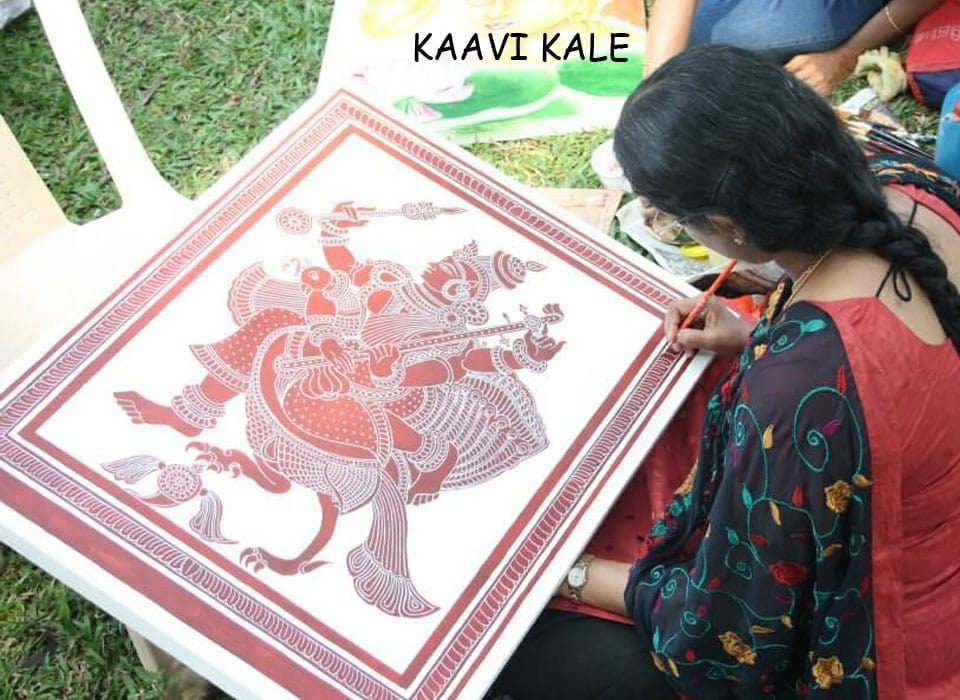“Preserve your memories, keep them well, what you forget you can never retell.”-Louisa May Alcott
10 interesting things I learnt about ‘Kaavi kale’ from the artist Mrs.Veena Srinivas
1. The ‘Aha’ moment when I learnt the name
I have to mention this. Though I had already come across this art form on some temple walls in North Karnataka I did not know it was called ‘Kaavi kale’. So yes, this is the first thing I learnt . Thus named, because it is a monochromatic red colour with fine white lines. Kaavi is the colour of mud,an Indian red and Kale means art.

Mythological characters on the walls of Ram Mandir, Honnavar
PC- Dr.Krishnaji
2.This art form originated from the Konkan region under the patronage of Gaud Saraswat Brahmins
It is believed to have originated from them, but as there are no documents on this, nobody can be sure. The art form can also be found on some of the walls of houses in Goa. The Gaud Saraswat brahmins migrated south, with the Portuguese invasion of Goa and along with them, the art form. This can now be seen on temple walls in Sirsi, Kumta, Ankola, Honnavar, Mavinkurve, Kundapur, Udupi,Kollur and Ambalpady.
3. More than the features of this art, it is the method which is most astounding
Kaavi is the local name for the Indian red pigment also called ‘uramunji’,found in the laterite soil. As the coastal belt receives heavy rainfall, the art lovers from the Konkan region came up with this unique art form around the 16th century. To ensure it survives the tough weather conditions, locally available materials were used to prepare the wall for plastering. Seashells were burnt to obtain Snow White Lime, which was then mixed with jaggery and clean river sand. This was allowed to ferment over 2 weeks. It was then hand pounded to obtain a mixture as soft as butter but which would harden on application onto the wall. The kaavi pictures’ outline would be marked and then the butter like, lime mixture would be mixed with uramunji to obtain the Indian red for the murals. These were applied on to the wall for the portion marked and then using Steel bodkins the etchings were engraved as per design. This would expose the white lime just below the surface and result in the final image. This etching would be done when the application was neither too wet nor too dry. After a day’s drying, over a week this would be sprayed with water every four hours. After each spray they would be polished with smooth pebbles from river beds. This treatment prevented cracks in the mural and they lasted forever. When I say ‘forever’, Ram Mandir in Honnavar was constructed nearly four hundred years ago, but the beauty of the pictures on its walls has not diminished.
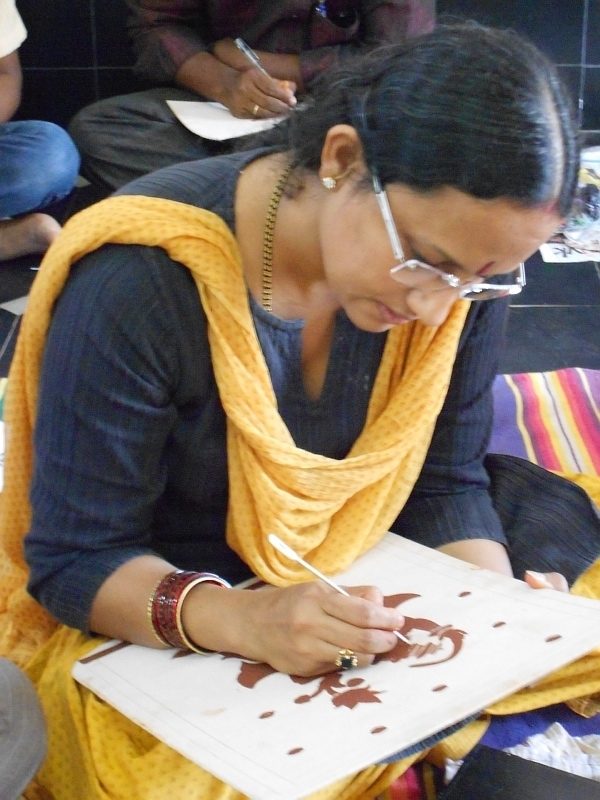
The artist partiipated in the Sampradayika Kaavi Kale workshop in 2012. This was conducted by the famous artist Ganjiffa Raghupathi Bhat. This was done using the traditional and aunthentic process of ‘Kaavi Kale’.
4. Change in career track from realistic art to ‘Kaavi Kale’
I have always been interested to interact with people who have changed their career track and learn what helps them make this transition. The artist, Mrs.Veena Srinivas had been working on realistic art for more than 8 years and was very successful at it. But she was candid enough to tell me, that she was having doubts about her artistic future. It was then, that she came across these beautiful paintings on the walls of Shri Mahalasa Narayani temple of Kumta constructed in 1565 A.D . The red colour and fine white lines called to the artist in her. She found that it was a dying art and decided to dedicate her time and talent to its revival. With this she found her niche and ‘calling’ as an artist. With three successful exhibitions, her initial misgivings on its reception were laid to rest. Sometimes the path you choose, becomes the path to your success and this was exactly what happened to the artist.
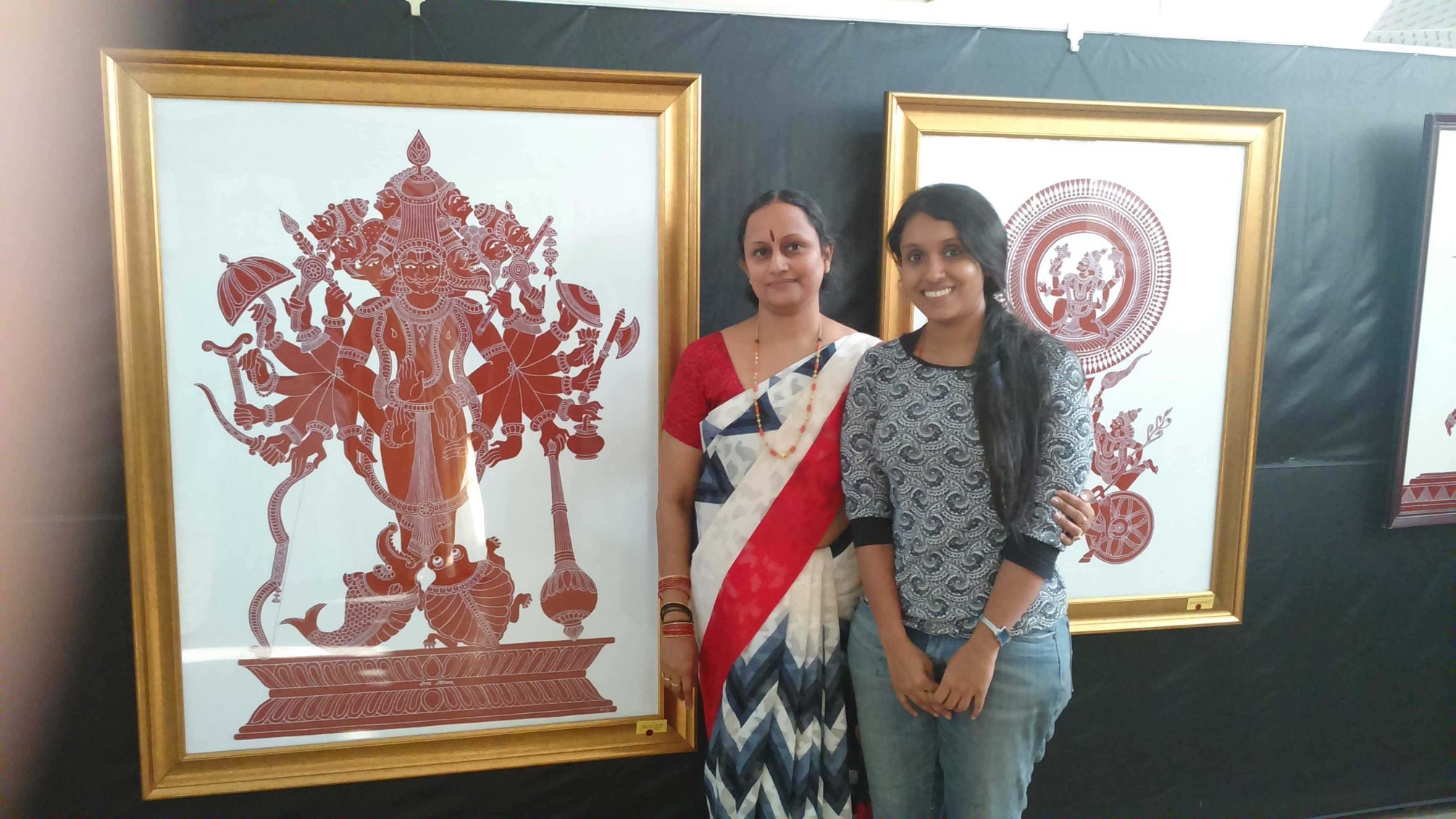
The artist with a friend at her exhibition. The Dashavataara, an original work of art by the artist.
5. Defining Characteristics of ‘Kaavi Kale’
In ‘Kaavi kale’, we mostly have mythological characters, geometric patterns and some common figures, such as men with boots, guns and topi(hat) which depicts the Britishers, ruling India at the time. There are images of the brahmin performing pooja, a dancer, a couple relaxing and so many more. So this art form was a reflection of the life around them. In Kollur Mookambika Temple some original figures are still retained. It is interesting to see art reflecting the times and the passage of time. The Gods and Goddesses also have particular features. The ladies have the nose ring, elaborate hair-dos and ornaments, the nine yard saree tucked at the back (kaccha form). The detailing can be seen in the beautiful long delicate fingers and intricate ornaments.
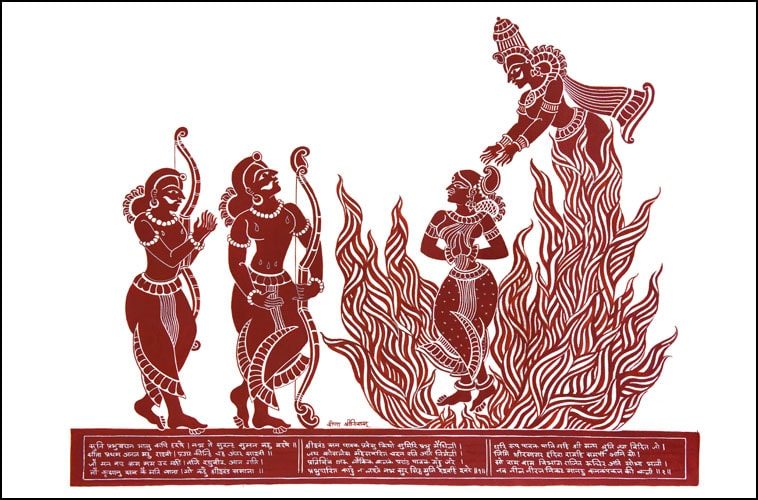
Sita giving the agni pariksha(test by the fire) to prove her purity, an original work of art by the artist- A part of Ramayana Series
6. Gods with moustache
This is a deviant from most art forms, where Gods do not sport moustaches. Be it Kerala mural art form or any other, we see that clean faces and aesthetic appeal mark the Gods. The moustache is only reserved for the demons and the villains. But in Kaavi kale Ram and Ravan both have moustaches……

War between Rama and Ravana, an original work of art by the artist- A part of Ramayana Series
7. No documents on the art were available, the only source of information was a book by Dr.Krishnanand Kamath
When Mrs.Veena Srinivas came across this art form, she wanted to know all there was to it. Sadly, she found that there were absolutely no records with the temple authorities. The main and only source of information was a book by Dr.Krishnanand Kamath. He was the first researcher to elaborately study and document ‘Kaavi Art’. His books ‘Kaavikale’ (in Kannada) and ‘Konkanyangele Kaavikala’ (in Konkani) are the most authoritative works on Kaavi murals.

‘Konkanyangele Kaavikala’ (in Konkani) by Dr.Krishnanand Kamath
8.Some history lost with temple renovations
As I go through the book, I discover that some of the pictures and temples mentioned by Dr.Kamath no longer have ‘Kaavi kale’ on their walls. When temples opt for renovations and sturdier options for walls like granite, a part of history is lost… Unfortunately irretrievably lost.

9.Artist’s message- We have no right to destroy, that which we cannot create
But we can work on what is available and when I asked the artist the way forward for the art, she says that we can retain some aspects of the art if not on walls, at least on Canvas. She conducts workshops for 2 to 3 days introducing the participants to this art form. She has conducted workshops in schools across Mangalore and Channarayapattana. If we help the next generation appreciate the art form and impart the nuances, they can work and build on it going forward. At least they will not be ignorant like me, let them at least know what it is called.
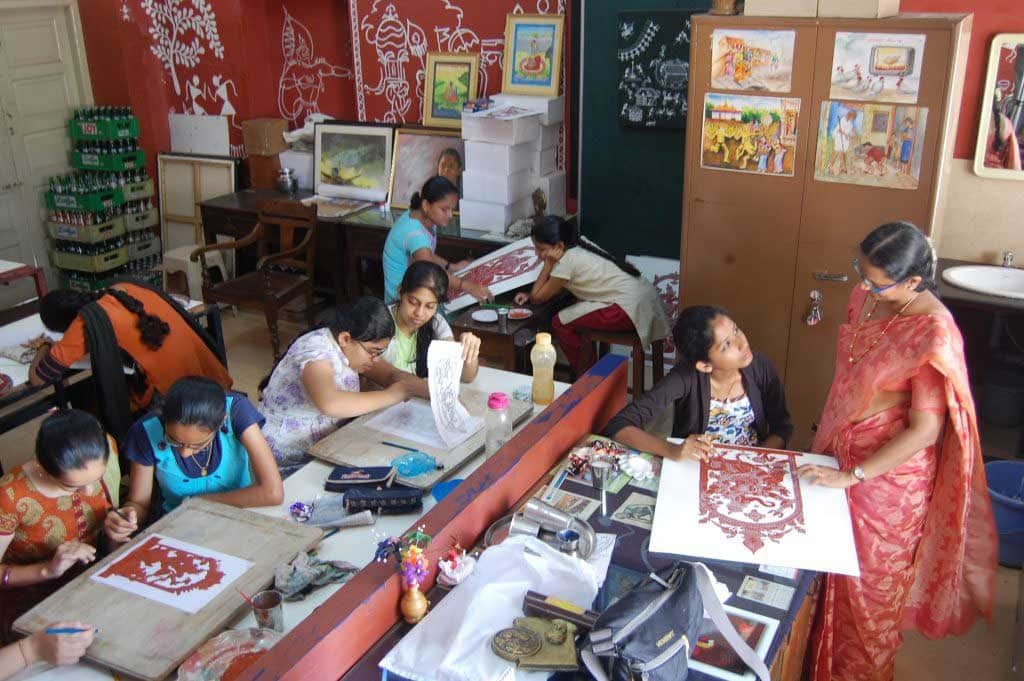
10. Don’t be afraid to stand alone
When someone is different let us encourage them. The artist found her inspiration and encouragement in divinity. Though she initially started with the murals on temple walls, the mythological characters, the Suryamandala, Chandramandala, Dashavataara, Sapthamatrikas and other designs, she says that there is scope for originality and creativity. She has completed her senior fellowship with the ministry of culture and depicted the Ramayana in 16 paintings. These are her original artworks which she has kindly shared with me here. Though the original process is not retained, the art is no longer confined to walls. She works with acrylic on canvas and watercolour on paper.
As we wind up, and my post goes up, the legacy is passed on….Write me your thoughts on this art form.
Twinkles to you…have a happy day.
Anupama
PC: Photos of the artist and original works of art belong to Mrs.Veena Srinivas and require her permission to be used.
Note- The artist can be contacted for orders or workshops at .
Workshops can be arranged for Bangalore. If groups of minimum 10 are interested, the artist can conduct the workshop. You can also contact me

